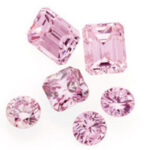Fine jewelry is that jewelry which is crafted from expensive metals like gold, platinum and silver and it may also feature gemstones like diamonds and pearls. Most people wear fine jewelry that they have either bought themselves or have received as gifts. As this type of jewelry is very expensive and is something you buy rarely, one must be very careful in selecting as well as caring for fine jewelry. Platinum is the most expensive and is harder than gold and silver. It is preferred because it is flexible, versatile and retains its color. Although it is similar to silver in looks it does not loose its luster like silver. It is also hypo allergenic, which means that those with sensitive skins can use it safely. Here are some fine jewelry selection and care tips.
The type of jewelry you buy should suit your personality and taste. Jewelry should not only complement your personality, but also it should suit your dressing style and body shape. For example if you have stubby fingers you would of course like to divert attention from them rather than attract it. In such a situation it may not be prudent to wear attractive rings in your fingers. Those who have a taught midriff can draw attention to it by belly button rings. If you are the shy type, you may like to buy jewelry that is not flashy. Similarly a star may use flashy styles while a corporate executive would obviously prefer the subtler style.
Many people believe that different gemstones suit different personality traits. Birthstones are selected according to the date of birth of the individual. Some astrologers even believe that some gemstones have healing properties and have the power to influence the destiny of the person wearing them. A lot of symbolism is also attached to gem stones and their color. As it is believed that red is the color of passion and love rubies are associated with such emotions. Similarly blue being the color of innocence is associated with sapphires. Shape is a major consideration in the selection of fine jewelry. The beauty of jewelry comes from material used as well as the shape and pattern given to it by the designer. The setting of gemstones are shaped to complement their cut.
There are many technicalities involved in the selection, handling and storage of fine jewelry. Hardness is an important factor where jewelry is concerned. Similarly one must understand about purity and hardness because the precious metals and gemstones used in fine jewelry come in various grades of purity, clarity and hardness. The purity of gold is expressed in karats on a scale to 0 to 24, 24 karat being 100% pure. Gold is mixed with other non precious metals. Karat expresses how many parts pure gold is present in 24 parts of the metal. Thus 20 karats gold contains 20 parts pure gold and 4 parts other metals.
Jewelers and gem traders express the hardness of gemstones and precious metals in moh. The mohs scale is used for comparing hardness and is structured so that one substance that is rated at a particular number on the scale can scratch substances with lower numbers on the scale. Diamond is the hardest and its hardness is 10 mohs. Sapphires and rubies are 9 moh. Thus diamond having a higher moh can scratch rubies and sapphire. Topaz and emeralds are 8 moh and garnets, quartz and tourmalines are 7 moh. Anything having less than 7 moh hardness like opal, lapis lazuli, pearl and turquoise, can be scratched easily. The harder the gem the less vulnerable to damage it is. Diamond is “forever” because it is the hardest.
This knowledge about hardness comes in handy while storing and handling to prevent scratching of one material by another. Metals like gold silver and platinum used for making fine jewelry are between 2.5 to 4 mohs and hence they require special care during handling and storage. Like gold, for most ordinary uses pure silver is quite soft and hence it is mixed or alloyed with other metals. The standard silver alloy is 92.5% pure which means that the rest 7.5% constitutes another metal, usually copper. As per law in order to be called “sterling” silver must be at least 92.5% pure. Sterling silver jewelry carries a STR marking, for example STR .925 for 92.5% silver. Unless the jewelry is not marked as such it is not sterling silver. In the United States to be legally considered as gold it must be at least 10 karats.
There are some precautions that you must follow while wearing, handling and storing fine jewelry. Avoid heaping all your jewelry into the drawer. Likewise don’t overcrowd your jewelry box and keep your gemstone studded jewelry, pearls, gold and silver pieces separated to prevent scratching. Also small pieces can fall of while removing the larger ones. Forcing too much jewelry into a small space might bend or chip the softer metals and stones. Recalling what we have learned about hardness, a diamond ring can easily scratch your precious pearl necklace. Even though diamond is the hardest material it can get scratched by another diamond. Also jewelry might get entangled and break while attempting to separate them. Keep your jewelry separated in tissue paper, silk, velvet or plastic zip lock bags. Pearl needs extra care as it is easily scratched. When the cord in holding your pearls together starts getting frayed get it restrung. Avoid extremes of temperature and humidity while storing fine jewelry. Clean your jewelry as often as necessary. to maintain its sparkle and beauty.
Jewelry also needs to be taken care of while wearing. You must know when to put on jewelry and when to take it off. You should not be wearing your fine jewelry while applying perfume, makeup or hairspray. Avoid handling your pearls and gems as little as possible as they can become dull in appearance due to the buildup of skin oil. It is advisable to wear your bracelet in your left hand if you are right handed and vice versa. Fine jewelry must not be worn while you are engaged in gardening or housework. It might get entangled and broken While doing housework or gardening a bracelet can be easily broken or deshaped if it gets caught in a hook. Gems can get cracked or chipped if they are knocked against hard surface. They might also come off. Some harsh solvents contained in cleaning chemicals can damage jewelry especially pearls. Earrings must be removed before having your hair styled as they might get caught in the stylist’s comb. Take off your pearls while having your hair colored as they may lose their luster. Chlorine products used in swimming pools for preventing growth of bacteria can be harmful to your fine jewelry, so remove them before getting in.
Care must also be taken while shipping or transporting your fine jewelry. Some simple precautions will ensure that your precious possessions reach their destination safely. Package your jewelry in appropriately sized boxes so that there is not too much free space. Wherever possible use appropriately designed boxes to hold the specific type of jewelry so that it will be more secure. If this cannot be done, each piece of jewelry can be wrapped in cloth separately and placed in the box and the empty spaces filled with cloth or paper to prevent the jewelry from shifting. For extremely expensive jewelry it is advisable to buy insurance and if you are shipping it, to use a company like DHL, UPS or Federal Express that allows tracking of the package, so that you will know when it reaches its destination.



